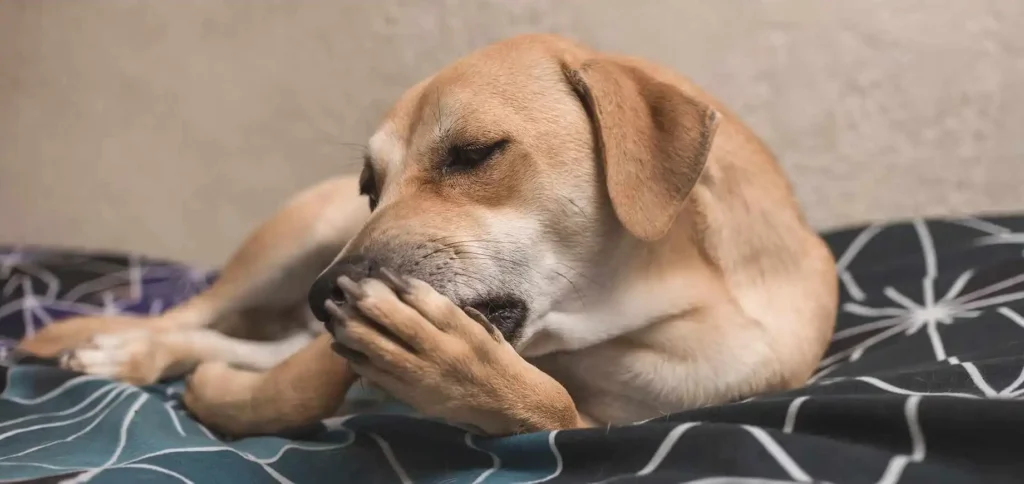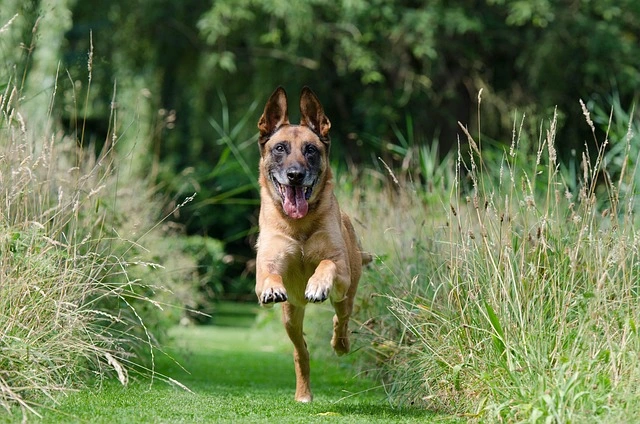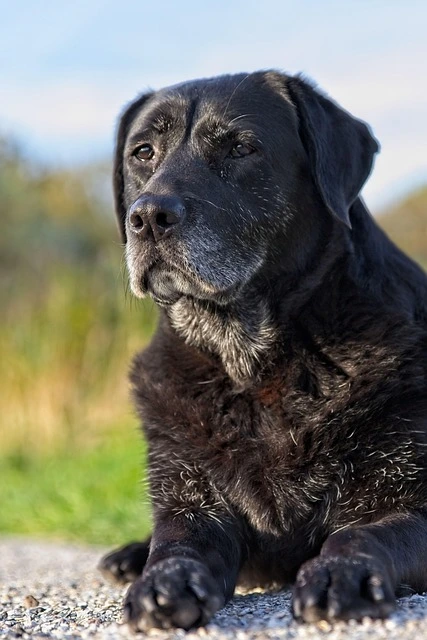You’ve settled in for a quiet evening when that familiar sound starts again—slurp, slurp, slurp. Your dog is back at it, obsessively licking their paws while you wonder what’s driving this strange behavior. If your dog constantly licking paws has become the household soundtrack, you’re certainly not alone in your frustration and concern.

Table of Contents
Quick Answer
Dogs constantly lick their paws due to allergies, injuries, parasites, dry skin, anxiety, or underlying health conditions affecting their joints or immune system. This seemingly innocent behavior can indicate pain, discomfort, or irritation that requires attention. Identifying the root cause allows targeted treatment that can bring relief to both you and your furry friend.
TL;DR: Excessive paw licking usually signals discomfort from allergies, injuries, or anxiety. Quick home solutions include gentle cleaning, paw soaks, and protective booties, but persistent licking needs veterinary evaluation.
Why It Matters
While occasional paw licking is normal grooming behavior, constant licking can quickly become problematic. Left untreated, your dog’s persistent paw licking can lead to:
- Moist dermatitis (hot spots)—painful, red, inflamed skin lesions
- Secondary bacterial or yeast infections requiring medication
- Hair loss and skin discoloration (often a rusty-brown color)
- Lick granulomas—raised, hard skin lesions that may bleed and won’t heal easily
- Chronic pain and discomfort affecting your dog’s quality of life
- Behavioral problems from constant discomfort and poor sleep
Most concerning is that excessive paw licking often signals an underlying issue that could worsen without proper attention. Rather than simply treating the symptom, understanding the cause ensures your dog gets appropriate relief.
Tools & Product Recommendations for Paw Relief
Paw Soother Balm for Sensitive Paws
This natural balm is perfect for dogs with chronically dry or cracked paw pads. It contains shea butter, coconut oil, and vitamin E that create a protective barrier while moisturizing. Great for smaller breeds whose paws are more vulnerable to environmental irritants. The non-greasy formula absorbs quickly, though it does require regular application for best results.
Paw Washer Cup for Active Dogs
Ideal for outdoorsy dogs who encounter allergens during walks or hikes. This portable cup has soft silicone bristles that gently clean between paw pads and remove allergens before they cause irritation. Works wonderfully for medium to large breeds who love outdoor adventures. The simple design makes daily cleaning quick and easy, though it does require refilling with fresh water for each paw.
Protective Dog Booties for Environmental Allergens
These waterproof boots provide excellent protection for dogs with environmental allergies or sensitivity to outdoor irritants. The adjustable straps ensure a secure fit without restricting movement, making them suitable for dogs of all sizes. They’re particularly valuable during seasons with high pollen counts or in areas with treated lawns. The only drawback is some dogs need training to accept wearing them.
Anti-Lick Deterrent Spray
A bitter apple spray that discourages licking while allowing healing. This alcohol-free formula is safe for sensitive skin and won’t sting existing irritations. Best for dogs who have developed a habit of licking even after the original irritant is addressed. While effective for most dogs, some particularly determined chewers might ignore the bitter taste after initial exposure.
Step-by-Step Guide to Stop Your Dog’s Paw Licking
- Examine the paws closely. Gently spread each toe and look for foreign objects, cuts, redness, swelling, or abnormal growths. Use good lighting and check between toes where irritants often hide.
- Clean paws thoroughly. Use lukewarm water and a mild, fragrance-free dog shampoo to wash paws, making sure to clean between toes. Rinse completely—leftover soap can cause further irritation.
- Try a soothing paw soak. Fill a shallow container with enough warm water to cover paws and add 1 tablespoon of Epsom salt per cup of water. Soak affected paws for 5-10 minutes, then dry thoroughly. Limit to 1×/day for 3–5 days, avoid on open wounds.
- Apply appropriate topical treatment. Based on what you observed, use either a moisturizing balm for dry pads, antibacterial solution for minor cuts, or vet-approved hydrocortisone cream for inflammation only on intact skin, short course; stop if no improvement in 48–72h.
- Implement environmental changes. Wipe paws after walks, consider protective booties for outdoor activities, use pet-safe ice melt in winter, and create a designated clean path in your yard.
- Address potential allergies. Switch to a limited ingredient diet for 8-12 weeks if food allergies are suspected. Remove potential household allergens like scented cleaners, certain fabric softeners, or wool rugs.
- Provide alternative focus. Offer puzzle toys, lick mats, or appropriate chews to redirect your dog’s attention when you notice licking behavior starting.
- Consider anxiety management. If stress seems to trigger licking, create a consistent routine, provide adequate exercise, and consider calming aids like L-theanine supplements or pheromone diffusers.
Understanding Dog Paw Anatomy
A dog’s paw contains digital pads under each toe, a central weight-bearing pad, possible dewclaws, and interdigital spaces between toes that are prime spots for irritation. These areas contain numerous sweat glands and sensitive nerve endings that detect temperature, pressure, and pain, making them highly responsive to irritants. The skin on paws is thicker than elsewhere but remains vulnerable to damage from rough surfaces, chemicals, and temperature extremes.
Many dogs develop paw irritation from environmental factors. Border Collies and other active breeds commonly experience paw sensitivity after exposure to winter salt, summer-heated pavements, or lawn treatments. Regular inspection helps catch these issues before they escalate into chronic licking problems.
Allergy vs. Injury vs. Infection: Quick Comparison
Allergy Signs
- Licking multiple paws, not just one
- Seasonal patterns often present
- May include face rubbing and ear scratching
- Redness between toes and on paw pads
- Often worsens after walks or during specific seasons
Injury Signs
- Usually affects just one paw
- Limping or favoring the paw
- Visible wound, foreign object, or broken nail
- Dog may resist touch to specific area
- Sudden onset rather than gradual development
Infection Signs
- Swelling and unusual warmth
- Strong odor (often yeasty or foul)
- Discharge or pus present
- Dark reddish-brown discoloration from saliva
- Paw may feel greasy or abnormally moist
Breed Sensitivity Guide
- Small Breeds (under 20 lbs): Yorkshire Terriers, Maltese, Shih Tzus Often have hair growing between paw pads that traps allergens; prone to contact allergies from household cleaners due to their low proximity to floors
- Medium Breeds (20-50 lbs): Bulldogs, Shar-Peis, Cocker Spaniels, Beagles More susceptible to food allergies manifesting as paw licking; deep skin folds between toes can harbor yeast
- Large Breeds (50-90 lbs): Labrador Retrievers, German Shepherds, Golden Retrievers Commonly develop environmental allergies; weight puts pressure on paws making injuries more problematic
- Giant Breeds (90+ lbs): Great Danes, Mastiffs, Saint Bernards Prone to joint issues that cause compensatory licking; paw pad issues more serious due to weight distribution challenges
Common Mistakes (and Fixes)
Ignoring seasonal patterns. The fix: Keep a simple log of when licking increases to identify potential environmental triggers like pollen, mold, or lawn treatments.
Using human medications without guidance. The fix: Consult your vet before applying any human-grade antihistamines, steroids, or pain relievers, as improper dosing can be dangerous.
Focusing only on the paws. The fix: Check your dog’s entire skin for other signs of allergies or infection that might provide clues to what’s affecting the paws.
Overwashing paws. The fix: Limit washing to once daily unless otherwise directed, as excessive cleaning strips natural oils and can worsen dryness.
Allowing licking immediately after treatment. The fix: Use an E-collar or recovery suit temporarily to allow topical treatments time to work.
Missing psychological factors. The fix: Address possible anxiety or boredom with increased mental stimulation and physical exercise appropriate for your dog’s age and breed.
Using scented products. The fix: Switch to fragrance-free detergents, floor cleaners, and pet products, as artificial fragrances are common irritants.
Troubleshooting (If/Then)
If your dog only licks after walks, then clean paws immediately upon returning home and consider the route you’re taking (avoiding freshly treated lawns or areas with high pollen counts).
If the licking is worse at night, then your dog may have pain or anxiety that becomes more noticeable in quiet moments; try providing a comfortable bed away from drafts.
If one paw is affected more than others, then check carefully for a foreign object, cut, broken nail, or insect bite that might be causing localized pain.
If licking started after a food change, then consider returning to the previous diet and introducing a limited ingredient alternative with novel protein sources.
If your dog also scoots their bottom, then check for anal gland issues which can trigger referred discomfort behaviors like paw licking.
If licking improves with antihistamines (vet-approved dosing only; not all dogs should take them), then allergies are likely the culprit; work with your vet on a comprehensive allergy management plan.
If your dog’s paws smell yeasty or like corn chips, then a yeast infection may be present requiring antifungal treatment from your veterinarian.
When to See a Professional
Contact your veterinarian immediately if you notice:
- Limping or inability to bear weight on the affected paw(s)
- Bleeding, pus, or discharge from the paw
- Broken nails that expose the quick (pink area inside the nail)
- Foreign objects embedded in the paw that you cannot easily remove
- Excessive swelling, heat, or obvious pain
- Paw licking accompanied by other symptoms like lethargy, fever, or decreased appetite
- Any sudden changes in behavior along with paw licking
These symptoms could indicate serious conditions requiring prompt medical attention, from deep infections to fractures or even systemic health issues.
What a Vet Will Do
When home remedies don’t resolve your dog’s paw licking, veterinary intervention often provides answers and relief through:
- Diagnostic tests: Skin scraping to check for mites, cytology to identify bacterial or yeast infections, and cultures to determine specific pathogens and appropriate treatments.
- Allergy workup: Elimination diet trials, intradermal skin testing, or blood tests to identify specific allergies, followed by a customized management plan that may include immunotherapy.
- Medication options: Prescription-strength anti-inflammatories, antibiotics for bacterial infections, antifungals for yeast, or specialized drugs like apoquel or cytopoint that target the itch-scratch cycle at its source.
- Advanced treatments: For severe cases, your vet might recommend medicated foot soaks, custom-compounded topicals, or even low-dose long-term antibiotics for chronic issues.
- Behavioral assessment: If medical causes are ruled out, your vet may recommend a veterinary behaviorist to address compulsive behaviors or anxiety-driven licking.
Frequently Asked Questions
Is excessive paw licking always due to allergies?
No, while allergies are a common cause, dogs also lick their paws due to injuries, infections, parasites, dry skin, anxiety, or even boredom. A thorough examination helps determine the specific trigger for your dog’s behavior.
How can I tell if my dog’s paw licking is behavioral or medical?
Medical causes usually show physical symptoms like redness, swelling, or injury. Behavioral licking often occurs in patterns (during stress, when alone) and may stop with distraction. When in doubt, consult your vet to rule out medical issues.
Can certain foods cause paw licking?
Yes, food allergies commonly manifest as paw licking. Common culprits include chicken, beef, dairy, wheat, and soy. An elimination diet under veterinary supervision can help identify food sensitivities.
How effective are dog booties for preventing allergen contact?
Dog booties can be highly effective for preventing contact with environmental allergens but require proper fit and gradual training. Most dogs adjust to wearing them within 1-2 weeks of consistent, positive introduction.
Could my cleaning products be causing my dog’s paw irritation?
Absolutely. Household cleaners, floor treatments, fabric softeners, and lawn chemicals can all irritate a dog’s sensitive paw pads. Switch to pet-safe alternatives and rinse floors thoroughly after cleaning.
Is seasonal paw licking normal?
Seasonal increases in paw licking often indicate environmental allergies to pollen, mold, or grasses. While common, this isn’t “normal” and should be addressed to prevent discomfort and secondary infections.
Can anxiety medication help with compulsive paw licking?
For dogs whose licking has become a compulsive behavior or stems from anxiety, prescription medications may help break the cycle when combined with behavior modification and addressing any underlying physical causes.
Conclusion
When your dog constantly licking paws becomes an ongoing issue, it deserves your attention rather than dismissal as a quirky habit. By understanding the potential causes—from allergies and injuries to anxiety and infections—you can take appropriate steps toward providing relief. Start with the simple solutions like proper cleaning, environmental adjustments, and protective measures. Monitor for improvements, and don’t hesitate to involve your veterinarian if the problem persists or worsens.
Remember that your dog’s paws are their foundation for exploration, play, and daily activities. Taking care of these sensitive structures isn’t just about stopping an annoying behavior—it’s about improving your companion’s quality of life. With patience, observation, and the right approach, you can help your dog put their best paw forward and leave excessive licking behind.
For more information about managing your dog’s skin conditions, check out the AVMA’s guide to skin conditions in pets.

